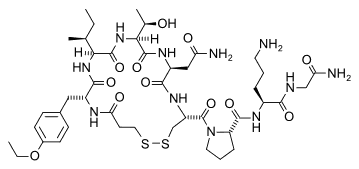* Gyetvai K, Hannah ME, Hodnett ED, Ohlsson A. Tocolytics for preterm labor: a systematic review. Ob Gynecol 1999; 94:869-77.
CLINICAL QUESTION
How effective are tocolytics for the treatment of preterm labor?
BACKGROUND * Tocolytic drugs have not been shown to reduce the number of preterm deliveries but may prolong pregnancy for up to 48 hours. Postponing delivery may allow the administration of corticosteroid drugs to enhance pulmonary maturity and reduce the severity of respiratory distress syndrome.[1]
POPULATION. STUDIED * The patients included were women in a referred care setting presenting with preterm labor. Seventeen studies published from 1966 to 1997 involving 2785 patients met the final criteria. Five studies used ritodrine as the tocolytic; 4 used magnesium sulfate; 3 used indomethacin; 2 used terbutaline; 2 used atosiban; 1 used isoxsuprine; and 1 used ethanol.
STUDY DESIGN AND VALIDITY * The authors conducted a comprehensive search of MEDLINE and the Cochrane Controlled Trials Register to identify articles for this review. A study was included if it was a placebo-controlled randomized trial evaluating the effect of a tocolytic on women in preterm labor and reported perinatal, neonatal, or maternal outcomes.
Potential biases in this meta-analysis may limit the implications for clinical practice. A few studies had relatively small sample sizes. The definition of preterm labor varied among the studies, raising the question of an accurate diagnosis. Three studies included women with ruptured membranes. The use of corticosteroids and antibiotics was not specified. Studies from the 1970s using ethanol and isoxsuprine, which are no longer used as tocolytics, may not be clinically relevant. Early gestation preterm labor [is greater than] 30 weeks) was not addressed separately even though the use of tocolytics in early versus late premature labor may have significantly different outcomes.
OUTCOMES MEASURED * The primary outcomes measured were duration of prolonged pregnancy, perinatal/neonatal outcomes, and maternal adverse effects. Meta-analyses were done for each outcome for all trials and for specific types of tocolytic therapy when possible.
RESULTS * Tocolytics decreased the likelihood of delivery within 24 hours (odds ratio [OR] = 0.47; 95% confidence interval [CI], 0.29 - 0.77), 48 hours (OR = 0.57; 95% CI, 0.38 - 0.83), and 7 days (OR = 0.60; 95% CI, 0.38 - 0.95). Specifically, betamimetics, indomethacin, atosiban, and ethanol (but not magnesium sulfate) were associated with significant prolongation of pregnancy. Tocolytics were not associated with significant reduction in births before 30, 32, or 37 weeks' gestation. Tocolytics were not associated with significantly reduced rates of perinatal death, respiratory distress syndrome, intraventricular hemorrhage, necrotizing enterocolitis, patent ductus arteriosus, neonatal sepsis, seizures, hypoglycemia, or birth weight of [is greater than] 2500 grams. Maternal adverse effects significantly associated with tocolytic use were palpitations, nausea, tremor, chorioamnionitis, hyperglycemia, hypokalemia, and the need to discontinue treatment. Specifically, betamimetics were associated with increases in most maternal side effects.
RECOMMENDATIONS FOR CLINICAL PRACTICE
Tocolytic drugs can prolong pregnancy for at least 48 hours and possibly up to 7 days, but there is no convincing evidence of reduction in preterm delivery or perinatal morbidity or mortality. The delay in delivery afforded by a tocolytic agent, however, allows time for the administration of corticosteroids, which is associated with a significant reduction in neonatal morbidity and mortality.[1,2] The neonatal benefits of tocolysis combined with steroid administration may outweigh the maternal risks, particularly in the setting of extreme prematurity.
--Christine Hsieh, MD Thomas Jefferson University Hospital Philadelphia, Pennsylvania E-mail: christine.hsieh@mail.tju.edu
REFERENCES
[1.] Crowley P, Chalmers I, Keirse MJNC. The effects of corticosteroid administration before preterm delivery: an overview of the evidence from controlled trials. Br J Obstet Gynaecol 1990; 97:11-25.
[2.] Wright LL, Horbar JD, Gunkel H, et al. Evidence from multicenter networks on the current use and effectiveness of antenatal corticosteroids in low birth weight infants. Am J Obstet Gynecol 1995:173:263-8.
COPYRIGHT 2000 Appleton & Lange
COPYRIGHT 2001 Gale Group



